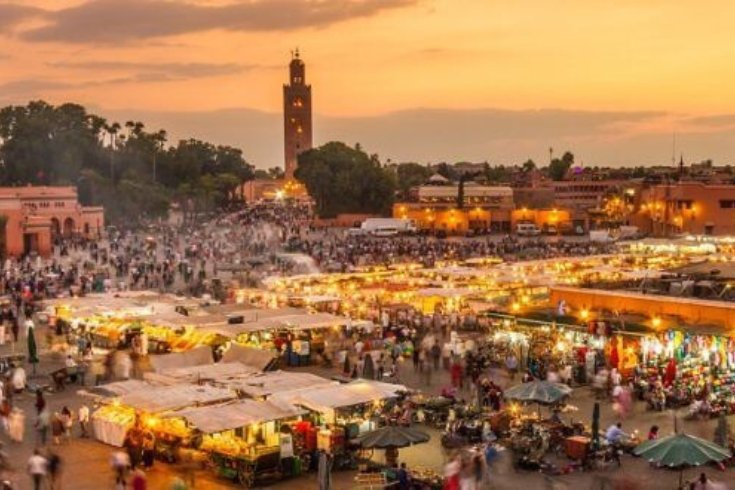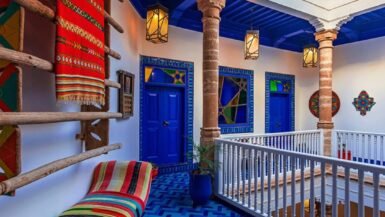It’s impossible to imagine visiting Marrakech without immersing yourself in the unique universe of Jemaa el-Fna Square, which is not just a monument, but the vibrant heart of the city, animated by life and culture. Jemaa el-Fna Square is a symbol of Marrakech and one of the most famous squares in the world, classified by UNESCO as an intangible cultural heritage of humanity. In this complete guide, we’ll explore the history of this ancestral square, its distinctive atmosphere by day and night, its unique performances, its popular restaurants, as well as practical advice for an unforgettable visit.
Location of Jemaa el-Fna Square and its Relationship with the Medina
Jemaa el-Fna Square in Marrakech is located in the heart of Marrakech’s Medina, forming a major meeting point and an axis connecting different parts of the historic city. It’s the nerve center where local residents and tourists from around the world meet.
Situation of the Square in the Heart of Marrakech’s Medina
Jemaa el-Fna Square occupies a strategic position, south of the main souks and west of the famous Koutoubia Mosque. This square constitutes the main gateway to the Medina for many visitors coming from outside the ramparts. It can be easily accessed on foot from any neighborhood of the old city, or by taxi which can stop nearby. Although it’s a pedestrian zone, it’s characterized by its expanse and ease of circulation.
History of Jemaa el-Fna Square: Roots of Legend and Life
The history of Jemaa el-Fna is rich and complex, witness to centuries of commerce, celebrations, and even tragic events. The mystery of its history adds to its charm and appeal.
Origins of the Square and Meaning of its Name
There are several interpretations about the origin of the name “Jemaa el-Fna”. Some link it to the word “mosque” (jemaa) and “courtyard” (fna) designating the space adjacent to the mosque, while others suggest it derives from “assembly of extinction,” which could be related to its use as an execution site in previous eras. Historians think the square dates back to the 11th century, being part of a city expansion project under the Almoravid era.
Evolution of the Square’s Role Through the Ages
Jemaa el-Fna Square has experienced numerous transformations over the centuries, serving as a commercial market, military square, and public execution site, before becoming a cultural and tourist center. Despite the changes the city has experienced, the square has maintained its social and cultural role, reflecting its resilience and importance in urban life.
Atmosphere of Jemaa el-Fna: Daytime Magic and Nighttime Pulse
What makes Jemaa el-Fna Square truly unique is its continuous transformation throughout the day, offering completely different experiences between morning and evening. A visitor in the morning will see a very different square from what they’ll discover in the evening.
The Square by Day: Relative Calm and Beginning Animation
During daylight hours, Jemaa el-Fna Square is characterized by relative calm compared to the night. Fresh juice stands, particularly refreshing orange juice, spread throughout the square. Snake charmers and macaque monkey owners begin to appear, as well as some storytellers and medicinal herb sellers. Morning and early afternoon are ideal times for taking photos before the arrival of large crowds.
The Square in Evening and Night: Peak of Effervescence and Vitality
At sunset, Jemaa el-Fna Square in Marrakech undergoes a dramatic transformation. It fills with thousands of people, hundreds of food stalls set up in its center, and musicians, acrobats, storytellers, and other artists occupy specific areas. The air is infused with the delicious smell of food, and the sounds of music, drums, and conversations blend into a noisy symphony. This atmosphere full of vitality creates a totally immersive experience that can only be described through living it.
Activities and Performances on Jemaa el-Fna Square: Theater of Daily Life
Jemaa el-Fna Square is a true open-air theater, where popular artists present their shows that attract crowds all day long, especially in the evening. These performances reflect the richness and diversity of Moroccan heritage.
Traditional Storytellers
Storytellers stand in the middle of circles of listeners, telling stories and legends passed down for centuries. They use Arabic or Berber in their narratives, using facial expressions and body gestures to animate their narrations. These storytellers are among the most important guardians of Moroccan oral heritage.
Musicians and Folk Groups
Various musical formations offer different genres of Moroccan music like gnawa and Berber music. These groups form circles around which listeners gather, and the performances are often accompanied by traditional dances reflecting the region’s heritage.
Snake Charmers and Macaque Monkeys
Among the most fascinating shows on Jemaa el-Fna Square, particularly during the day. Snake charmers perform their impressive acts amid tourist amazement, while macaque monkey owners attract visitors with their acrobatics. It should be noted that this subject raises sensitivities among some visitors concerned about animal welfare.
Acrobats and Street Performers
Acrobats offer shows including impressive movements and balance games demonstrating their strength and flexibility. These performances attract a wide audience, especially children and families.
Traditional Water Carriers
Traditional water carriers are distinguished by their colorful clothing and hats adorned with pompoms and bells. They offer water to the thirsty (usually for a tip or for photos), and constitute an important tourist icon of the square.
Henna Artists
Women offer temporary henna tattoo services on hands and feet, and are known for their complex traditional designs. Henna artists are particularly active during the day and early evening.
Games and Other Services
The square also includes spontaneous games, sometimes fortune tellers, and traditional medicinal herb sellers. There are also numerous juice stands, especially fresh orange juice which is one of the most popular drinks on the square.
Restaurants and Evening Food Stalls on Jemaa el-Fna
At sunset, Jemaa el-Fna Square dramatically transforms into the largest open-air popular restaurant in Morocco, with hundreds of stalls offering the most delicious traditional dishes. This experience is one of the most characteristic aspects of the square.
The Culinary Experience at the Stalls: Atmosphere and Flavors
Sitting down to dine in the heart of Jemaa el-Fna Square is a unique experience in itself. Smoke rising from grills, vendors calling to attract customers, long communal tables bringing together visitors from around the world, all this creates a feeling of intimacy and sharing amid the crowd.
The Most Famous Dishes Offered at the Stalls
The stalls offer a variety of traditional Moroccan dishes, including:
- Tangia Marrakchia – a very famous and distinctive dish from Marrakech
- Harira – a traditional Moroccan soup rich in ingredients
- Grilled meats – kebabs and kofta grilled with special Moroccan spices
- Grilled vegetables – a healthy and tasty option
- Fried fish – fresh and prepared in a traditional way
- Snails – for lovers of culinary adventures
- Sheep’s head – a bold choice for those wishing to experience authentic traditional dishes
- Various Moroccan salads – refreshing and full of flavors
- Tagine – available at some stalls in different varieties
Before ordering, it’s advisable to check prices (some stalls have numbered menus) and choose busy stalls to guarantee food freshness.
Shopping around Jemaa el-Fna and its Relationship with the Souks
Jemaa el-Fna Square is the main gateway to the fascinating world of Marrakech’s souks, making it an ideal starting point for traditional shopping. Although there are some vendors on the square itself selling juices, nuts, dried fruits, and small souvenirs, the real shopping experience begins in the vast network of covered alleys forming the Marrakech souks, located just north of the square.
These souks are characterized by their specialization, each dedicated to a specific type of craftsmanship and products, from carpets and leathers to spices, traditional clothing, and jewelry. A visit to these souks starting from Jemaa el-Fna Square is an essential experience for discovering authentic Moroccan craftsmanship.
Importance of Jemaa el-Fna: Living World Heritage
Jemaa el-Fna Square enjoys exceptional cultural and historical importance. It’s not simply a tourist site, but a symbol of Marrakech’s unique cultural identity. UNESCO has recognized its value as a living model of oral and intangible heritage of humanity.
The square represents a historic meeting point that has continued to play its role as a social, cultural, and commercial center to this day. It’s a place where diverse traditions meet and are presented daily, making it a unique example of popular heritage continuity despite the challenges of the modern era.
Visiting Jemaa el-Fna: Practical Guide and Important Tips
The experience of visiting Jemaa el-Fna Square is unforgettable. To make it as pleasant as possible while avoiding inconveniences, here are some practical tips.
Best Time to Enjoy the Square: Day and Evening
It’s strongly recommended to visit the square at least twice: once during the day (late morning or early afternoon) to see the daytime artists and familiarize yourself with the square’s layout, and once in the evening (from sunset) to enjoy the food stalls, the atmosphere at its peak, and the nighttime performances.
The square is easily accessible, being very central, and you can walk there from anywhere in the old city, or taxis can drop you off nearby. For an overview, it’s advisable to go up to one of the cafés with terraces overlooking the square to enjoy a panoramic view.
Safety Tips in Crowded Places
As in any crowded place in the world, you must be vigilant against pickpockets, especially in dense crowds at night or around artist performances. Make sure to secure your valuables and keep your money in a safe place. Stay calm and firm if you encounter an uncomfortable situation.
Interactions with Artists and Vendors
It’s very important to know that taking photos or videos of artists (snake charmers, monkeys, musicians, storytellers, water carriers) generally requires a tip. Be prepared to pay before or immediately after taking a photo if you choose to do so. Be polite but firm if you don’t want to pay or interact.
Interaction with Food Stalls
It’s advisable to check prices before ordering (look for numbered stalls with menus). Stick to busy stalls to guarantee food freshness. Don’t hesitate to sit down, you’ll be served.
For comfort, wear comfortable closed shoes (due to crowds and spills). Be prepared for noise, smoke from stalls, and sensory intensity.
Sites Near Jemaa el-Fna Square
Koutoubia Mosque
Located just west of the square, the Koutoubia Mosque forms a majestic backdrop. It’s distinguished by its tall minaret which is a prominent landmark on Marrakech’s horizon. (Note: entry is reserved for Muslims).
Marrakech Souks
The famous Marrakech souks are located directly north of the square, accessible through main entrances from the square’s edge. They form a maze of alleys filled with crafts and traditional products.
The Kasbah District
The Kasbah district is located south of the square, leading to Bahia Palace, El Badi Palace, and the Saadian Tombs. This area houses some of the most beautiful historic monuments in Marrakech.
Conclusion: Jemaa el-Fna, An Unforgettable Marrakech Experience
Jemaa el-Fna Square is not simply a tourist destination, but a complete sensory experience that takes you on a journey to the heart of Moroccan culture. With its changing atmosphere from day to night, its varied performances, its delicious cuisine, and its rich history, the square offers its visitors unforgettable moments.
We invite you to embrace the chaos and charm of Jemaa el-Fna Square, to taste its delicious dishes, to enjoy its unique performances (while respecting payment expectations), and to share your special moments from this exceptional place. Because Jemaa el-Fna is not just a site to visit, but an experience to live and carry with you forever.






Leave a reply